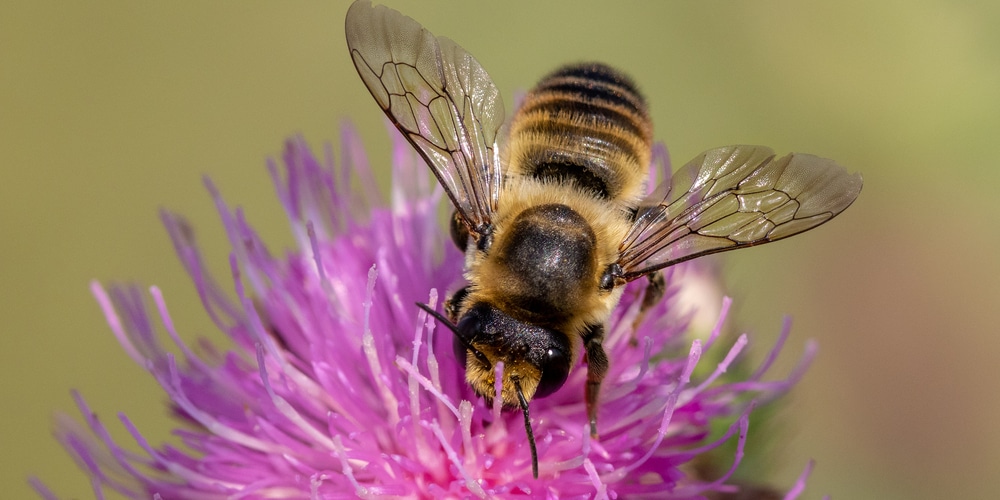Did you know that there are more than 20,000 species of bees? Well, if you didn’t, you know it now. Most of the time, when we think about bees, the first picture that comes to mind is that of honeybees.
However, the truth is that these insects come in various shapes, sizes (and even colors). And, despite what you may think, not all of them produce honey.
Sometimes, distinguishing between different bee species might be challenging. For instance, do you know the difference between a mason bee and a honey bee?
Keep reading if you don’t (and you are curious to find that out)! In this “mason bee vs honey bee” essential guide, we included everything you should know about the similarities and differences of these beneficial pollinators.
Mason Bee vs Honey Bee: Similarities
Mason and honey bees are both excellent pollinators. However, most people don’t know that only mason bees are native to North America. And while they do not produce honey, they collect nectar and pollen, which they need as sources of carbohydrates and proteins.
Both mason and honey bees have hairy bodies with black ad yellow stripes. However, a honey bee is usually more yellow since its thorax, body, and head come in this color.
Plus, mason bees have more hair on their bodies. In the following section, you can find other physical differences (and many more) to help you recognize them.
Differences between Mason and Honey Bees
There are more differences than similarities between mason and honeybees.
Mason bees are friendly and usually move for a range of about 100 meters. Also, their particular body structure (and hairs) allow them to pollinate around 95% of the blooms they visit. Indeed, these insects display “scopa hairs,” which can better suck up pollen.
Because they can pollinate up to 2,000 flowers in a day, they are much more effective pollinators than honey bees. Plus, they won’t sting unless it’s their last resource for survival. And even if they manage to do so, their bites aren’t more painful than those of mosquitoes.
On the other hand, honey bees can be annoying after they sting. Indeed, they produce a venom that causes plenty of inflammation around the affected area and can cause a severe reaction in people with allergies to bee stings.
While honey bees live in colonies, mason bees are solitary. For this reason, they don’t produce honey (which requires a lot of socialization and plenty of organization). Mason bees live in holes in brickwork and like to lay their eggs in masonry products (hence the name). Instead, honey bees construct intricate hives that contain up to 80,000 individuals.
Mason bees do not have queens and are not part of an organization involving workers and drones (as honeybees do). They usually die after mating. In a honeybee’s hive, only the queen will produce offspring. Their importance means she will live for up to four years.
Interestingly enough, despite being solitary, mason bees will help each other out when constructing their shelters. So, it might seem like a colony is occupying the same space, but just for a while.
Mason Bees vs. Honey Bees: How do their pollination differ?

As we mentioned before, mason bees are better pollinators than honey bees. Indeed, while the latter is more popular, the first doesn’t get the attention they deserve. Despite not producing delicious honey, mason bees are beneficial creatures to any ecosystem.
Honey bees collect pollen and place it in dedicated baskets in their bodies. While such practice might be “cleaner” and tidier, it results in less overall pollination. Indeed, the location of the pock minimizes the spread of pollen.
Because mason bees don’t have such a structure, they collect the pollen using their body hairs. On a good day, their entire body might become covered with pollen. And as the mason bees visit flowers, some of it will fall. The results are more random (thus, the pollination is more effective).
Honey Making: What Should You Know
The truth is that mason bees don’t produce honey because of their social behavior. If they weren’t solitary, they wouldn’t have issues doing it. Because honeybees live in hives, they follow a rigid hierarchical structure that allows them to produce plenty of delicious nectar.
And the process is probably not what you expect. Bees collect nectar from flowers using their “proboscis.” As they return to their hives, they “vomit” the nectar and store it in hexagonal cells. Then, they will let the substance dry. Over time, it will turn into honey.
Related Article: Do Honey Bees Like Lemongrass?

